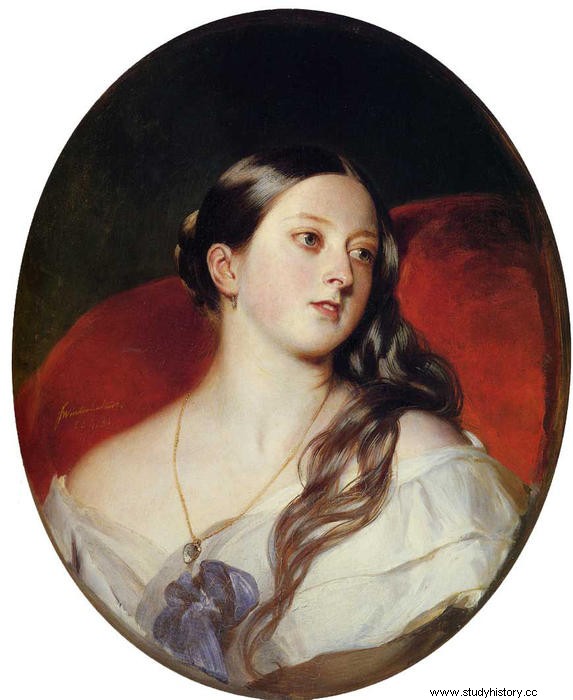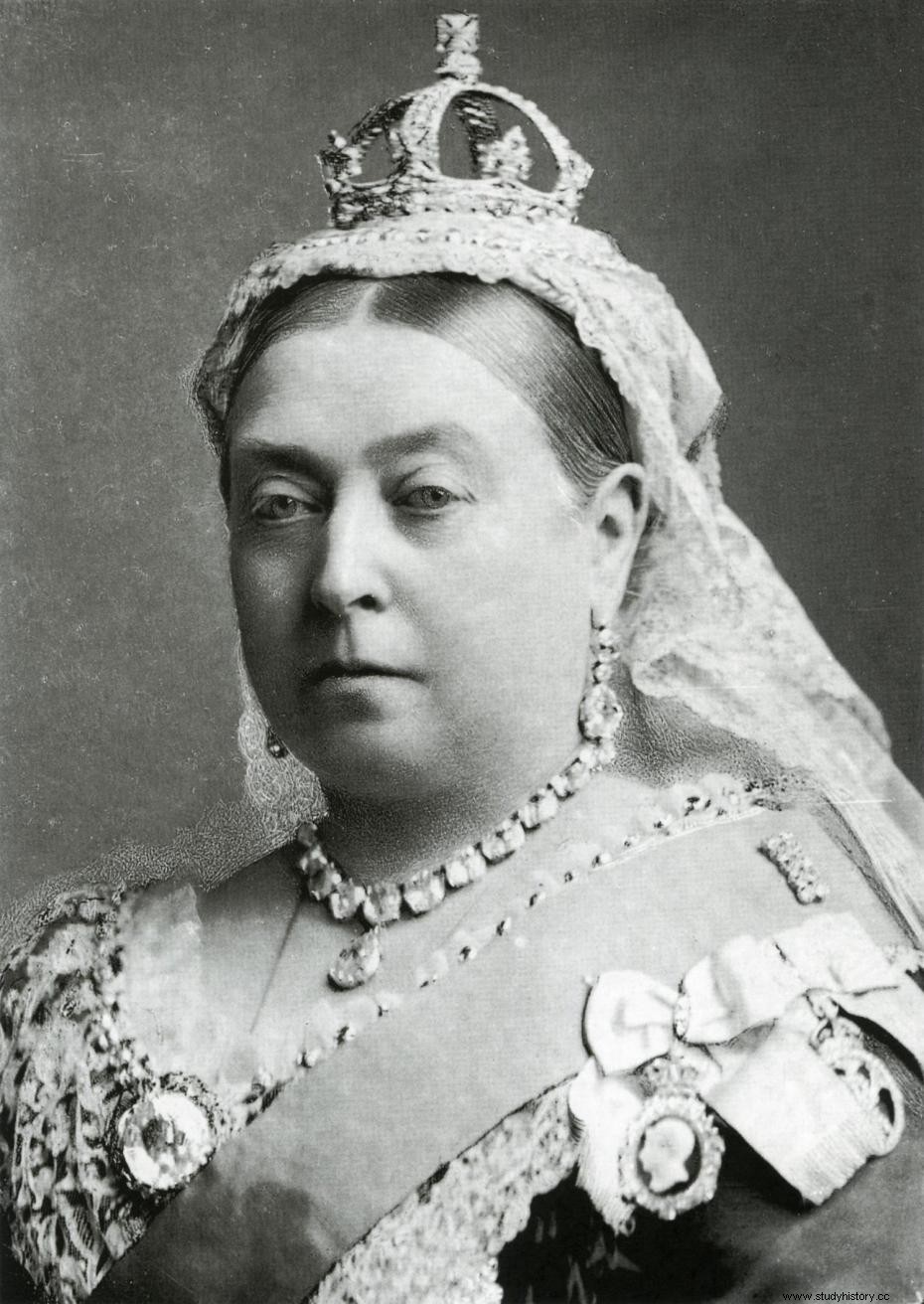Victoria, born Alexandrina Victoria (1819 – 1901) is a famous Queen of the United Kingdom of Great Britain and Ireland who also became Queen of Canada, Empress of India and Queen of Australia. His 63-year reign is one of the longest in UK history.
A strict upbringing
 Born May 24, 1819, Alexandrina Victoria is the only daughter of Princess Victoria of Saxe-Coburg-Saalfeld, German princess, and Prince Edward Augustus of Kent and Strathearn, the fourth son of King George III of the United Kingdom. Her mother already has two children from a previous marriage:Charles and Feodora. From birth, she is fifth in line to the throne of the United Kingdom. The following year, his father and grandfather died in quick succession.
Born May 24, 1819, Alexandrina Victoria is the only daughter of Princess Victoria of Saxe-Coburg-Saalfeld, German princess, and Prince Edward Augustus of Kent and Strathearn, the fourth son of King George III of the United Kingdom. Her mother already has two children from a previous marriage:Charles and Feodora. From birth, she is fifth in line to the throne of the United Kingdom. The following year, his father and grandfather died in quick succession.
Victoria's upbringing is severe and rather strict. Raised in part apart from children of her own age, she is subject to strict protocol, shares her mother's room and studies with private tutors. She learns in particular French, German, Italian and Latin. Two of her uncles died in 1827 and 1830, making Victoria, at the age of eleven, the heir presumptive to her last uncle, William IV. Her mother and John Conroy, her management controller, then took the young girl on many trips to England and Wales, where she was enthusiastically welcomed.
Prince Albert of Saxe-Coburg-Gotha
In 1836, her maternal uncle Leopold, who had become king of Belgium, planned to marry Victoria to her nephew, Albert of Saxe-Coburg-Gotha. They met in May 1836 and the girl immediately liked Albert. However, she is not yet ready to marry and no formal commitment has been made. William IV died on June 20, 1837 and Victoria became Queen of the United Kingdom and the British colonies; she was crowned on June 28, 1838. The government was then led by Prime Minister Lord Melbourne, who would have a great deal of influence over Victoria.
Popular early in her reign, Victoria saw her reputation tarnished following a court intrigue in 1839, when a lady-in-waiting was suspected of a pregnancy outside of wedlock. An examination reveals that the lady-in-waiting is a virgin and, accused of spreading false rumours, the queen is booed during public appearances. In October 1839, she and Albert met and fell in love again, and she proposed to him on October 15; the wedding takes place on February 10, 1840. Victoria is very much in love with her husband, who takes an important place as a political adviser at her side. The couple will have nine children.
“The Famine Queen”
Quickly pregnant after her marriage, the queen suffered an assassination attempt during this first pregnancy, but the bullets intended for her missed their target. The incident greatly increased the popularity of Victoria who, subsequently, would be the victim of other attacks:in May 1842, John Francis tried to shoot his carriage but his revolver did not work; in July 1842, John William Bean shoots him but his gun does not have enough power; in 1849, William Hamilton shoots his carriage; in 1850, former policeman Robert Pate attacked him with a cane. In March 1882, the poet Roderick McLean shoots his carriage.
 In 1845, following an epidemic of mildew, a great famine struck northern Europe and in particular the Ireland; in four years, a million Irish starve and as many emigrate. Nicknamed "The Famine Queen", Victoria gives more than any other individual donor to fight famine. At the international level, Victoria is particularly dedicated to relations between the United Kingdom and France, organizing several meetings between sovereigns. In 1848, frightened by the uprising of the Parisians, she took refuge for a while on the Isle of Wight, the time to make sure that the French revolution did not reach England.
In 1845, following an epidemic of mildew, a great famine struck northern Europe and in particular the Ireland; in four years, a million Irish starve and as many emigrate. Nicknamed "The Famine Queen", Victoria gives more than any other individual donor to fight famine. At the international level, Victoria is particularly dedicated to relations between the United Kingdom and France, organizing several meetings between sovereigns. In 1848, frightened by the uprising of the Parisians, she took refuge for a while on the Isle of Wight, the time to make sure that the French revolution did not reach England.
In 1853, Victoria tested the use of chloroform as an anesthetic during her eighth childbirth; impressed by its efficiency, she would use it again in 1857 despite the opposition of the clergy. In 1855, Napoleon III, an ally of the United Kingdom, traveled to London and the royal couple returned the courtesy the same year. In 1858, the French emperor was the target of an attack with a bomb made in the United Kingdom and the diplomatic crisis that followed led to the resignation of the government, without compromising relations between France and England.
Grandmother of Europe
In January 1858, the first daughter of Albert and Victoria married Prince Frederick William of Prussia, and the departure of her child caused great pain for the queen. Subsequently, the marriage of her children with European nobles earned her the nickname "Grandmother of Europe". In March 1861, his mother died and, during the period of mourning, Albert assumed many responsibilities. But on December 14 of the same year, he died of typhoid fever. Dejected, Victoria will mourn until the end of her life. Avoiding public appearances, she isolates herself but continues to carry out her governmental duties. This withdrawal favors the development of the republican movement.
Unfavorable to women's suffrage, Victoria supported the Reform Act in 1867. of 1860 which increases the number of men having access to suffrage. In 1870, following the establishment of the Third Republic in France, a republican rally demanded the abdication of Victoria. In 1871, Victoria and then her son, the Prince of Wales, fell seriously ill but both recovered and their popularity rose, weakening the republican movement.
In March 1893, a fall down the stairs caused her to limp for several months and the 74-year-old queen began to suffer from rheumatism. In 1884, Victoria published More Leaves from a Journal of a Life in the Highlands , following the book Leaves from the Journal of Our Life in the Highlands published in the 1960s. In 1887, the British Empire celebrated the Golden Jubilee – the fiftieth anniversary of her accession to power – of the popular Queen, then her Diamond Jubilee in 1897; she is then the longest-reigning monarch in British history. It remains so until September 9, 2015, when it is overtaken by Queen Elizabeth II.
Victoria died on January 22, 1901, in the presence of her son and successor Edward VII.
